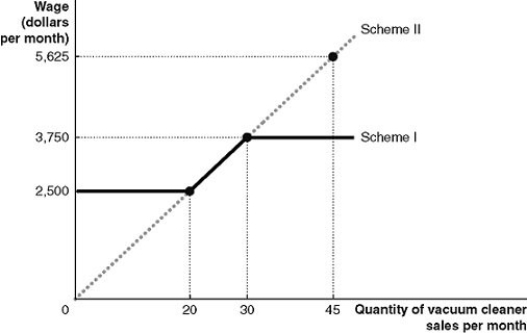Figure 17-6

Figure 17-6 shows two different compensation schemes for the Vortex Vacuum Cleaner Company.
Under Scheme I, the firm pays a consistent wage of $2,500 per month to all its salespeople for sales up to 20 vacuum cleaners. For sales of 21-30 vacuum cleaners, its salespeople earn $125 per vacuum cleaner, with wages capped at $3,750 per month for sales over 30 vacuum cleaners. If a salesperson has three consecutive months of sales below 20 vacuum cleaners, the person loses his or her job.
Scheme II represents a straight commission, with salespeople earning a commission of $125 per vacuum cleaner sold, with no wage cap.
-Refer to Figure 17-6.Which of the following statements about Scheme II is false?
Definitions:
General Mills
An American multinational manufacturer and marketer of branded consumer foods sold through retail stores, known for products like cereals, snacks, and more.
Vertical Marketing Systems
A coordinated approach to distribution and marketing designed to ensure that products or services flow smoothly from the producer to the consumer with the involvement of various intermediaries.
Channel Economies
The cost savings and efficiency gains derived from using effective distribution channels to deliver products or services to consumers.
Centrally Coordinated
Managed or organized from a single, central point, often referring to administrative or operational activities.
Q17: Which of the following characteristics describes an
Q56: Income inequality increases as the Gini coefficient
Q61: What is meant by the "law of
Q94: Joss is a marketing consultant.Iris and Daphne
Q161: An article on how prices in South
Q164: Refer to Table 18-5.The tax system is<br>A)progressive
Q165: Studies by the U.S.Census Bureau have shown
Q205: Arbitrage<br>A)is the act of buying an item
Q216: In the United States, the federal income
Q270: Which of the following factors will not